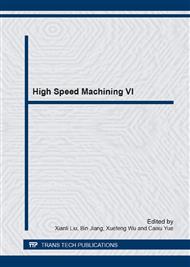p.585
p.590
p.596
p.601
p.607
p.613
p.619
p.627
p.633
Research on Surface Topography and Roughness of Micro Parts by High Speed Turn-Milling
Abstract:
High speed turn-milling has superiority on the productivity and the quality of work pieces, and is more suitable to machine micro-shaft parts and desirable miniature parts based on the turn-milling technology. In this papers adopting orthogonal experiment method cutting experiments of orthogonal turn-milling Aluminum alloy have been done. The relation between turn-milling regimes (cutter rotate speed, axial feed, feed per tooth etc.) and machined surface roughness has been ascertained. Finally, primary and secondary order of cutting regimes impacting surface roughness has more been confirmed through orthogonal experiments variance analysis, the rotate speed of cutter (cutting speed) influence greatly on surface roughness. Through 2-dimension surface topography diagram and 3-dimension surface topography of processed surface, it can be seen that high speed turn-milling processing technology can process micro miniature component of high surface quality, and features excellent development prospect and application value.
Info:
Periodical:
Pages:
607-612
Citation:
Online since:
July 2014
Authors:
Price:
Сopyright:
© 2014 Trans Tech Publications Ltd. All Rights Reserved
Share:
Citation:


